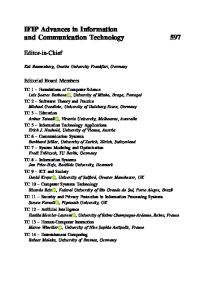An approach to the three-dimensional simulations of the Bosch process
- PDF / 176,994 Bytes
- 6 Pages / 584.957 x 782.986 pts Page_size
- 0 Downloads / 891 Views
The Bosch process is a high-speed, deep reactive ion etching technology for silicon, which has both excellent flexibility and selectivity. For better understanding and control of the time evolution of the feature profile during the Bosch process, an accurate, predictive, and fast simulation tool would be useful. In this article, a simplified model for three-dimensional simulation of the Bosch process is proposed. Etching is modeled by an isotropic etching rate superposed by an anisotropic term. For the passivation cycle, a perfect conformal deposition is assumed corresponding to a constant deposition rate. Level set method was used for tracking the surface evolution. Since the etching and deposition rates are the model input parameters which are not computed, the computational time is significantly reduced. Calculation results presented here illustrate some typical applications of the Bosch process.
I. INTRODUCTION
Micro(nano)electromechanical systems [M(N)EMS] belong to a rapidly expanding field of semiconductor fabrication technologies for producing micro- and nanoscale mechanical, electric, optical, fluidic, and other devices.1 The submicron structures typically found in microelectronics components can only be economically produced using different plasma processes.2–5 The nonequilibrium generation of reactants by plasmas enables the selective etching, deposition, implantation, removal, and cleaning of materials6,7 and surfaces required to fabricate microelectronics devices.8–11 Scaling down of device feature sizes together with increased complexity requiring a number of interconnect layers has brought out the need to develop plasma processes able to etch small features with very high aspect ratio (10–100).12,13 Standard reactive ion etching (RIE) of Si is widely used in the Integrated Circuits (IC) industry. It utilizes a synergistic balance of chemical etching and physical etching to produce Si trenches and structures with aspect ratios on the order of 5:1.14 However, MEMS devices may require extremely tall structures or extremely deep trenches. Standard RIE is incapable of meeting this requirement. The group of processes used to create deep trenches or high-aspect-ratio structures are called deep RIE (DRIE).15 Two leading technologies for high-rate DRIE are Bosch process and cryogenic process; although, the Bosch process is the only recognized production technique.16,17 The Bosch process consists of multiple cycles of alternating etches and depositions, advancing the trenches a)
Address all correspondence to this author. e-mail: [email protected] DOI: 10.1557/jmr.2011.416 J. Mater. Res., Vol. 27, No. 5, Mar 14, 2012
formed in small increments until the desired aspect ratio is reached.18,19 Each phase lasts several seconds. The deposition serves to protect the sidewalls during etching step, which causes the trench bottom to be selectively etched to extend the aspect ratio. During the etching phase, the directional ions that bombard the substrate attack the passivation layer at the bottom of the trench (but not alo
Data Loading...











